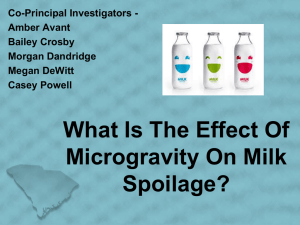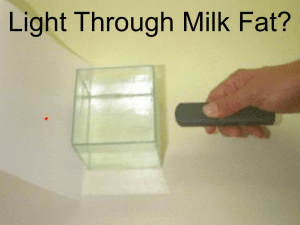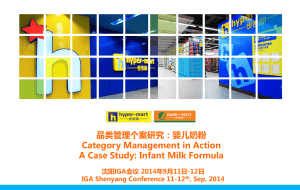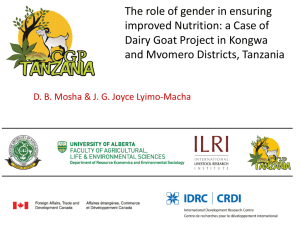Diapositive 1 - WordPress.com
advertisement
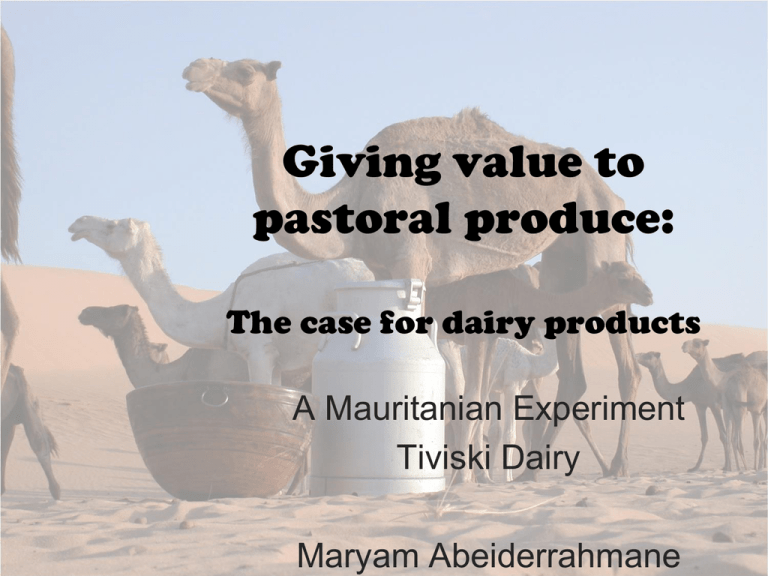
Giving value to pastoral produce: The case for dairy products A Mauritanian Experiment Tiviski Dairy Maryam Abeiderrahmane Mauritania Land area: 1,034,000 km2 in the Sahara and the Sahel. Rainfall: between 0 and 200 mm/year (except in the southernmost region). Population: app 3,000,000. In 1960, the population was 70% nomadic, now officially less than 15%. GDP per capita: app. $1,000. Agriculture: 20% of GDP, of which 75-85% is from stock raising. National herd (estimated): • 1,000,000 dromedary camels, • 1,500,000 cattle (zebu), • 8 – 12,000,000 sheep and goats. Public investment in the stock raising sector: 5 to 7% of total (up to 2007), and 33 to 45% of investment in the rural sector. Tiviski Tiviski: private enterprise (initially mini-dairy) set up in 1987 by Nancy Abeiderrahmane (née Jones). Basic concept: To establish a connection between the dairy potential of pastoral stock and city-based consumers of fresh produce, currently unable to access fresh milk, their basic foodstuff. Initial investment: FF 1,500000 (€230,000). First product in April 1989: Pasteurised camel milk in gable-top cartons. Financing, fully paid off: • Initial loan: FF 1,000,000 (€150,000) from the ADF. • UHT factory (2001): €2,000,000 from EIB, Proparco and SFI Tiviski Cumulative investment: app. € 4,000,000 Average annual turnover: € 3,100,000 Daily output: between 12,000 and the record of 22,000 litres/day. Suppliers: up to 1,000 families (seasonal variations). Personnel: 200, all Mauritanians. Direct and indirect jobs created: estimated at 3,000. Average gross profit between 1989 and 2007: 7.7 %, fully reinvested. Collecting the milk The diary industry is a bridge between milk from the herders and city-dwelling consumers. All the raw material – camel, cow and goat milk – is purchased from stock raisers, all of whom are nomadic: not a single farm exists. There are two collection points, located at 200 and 320 km from the factory: the milk is bought directly from the individual stock herders, without the use of middle-men or collectors. The price paid for the raw milk is very high: €0.45/kg for cow and goat milk, €0.57/kg for camel milk. The milk is collected and delivered twice a day, over a radius extending as far as 90 km, by private, independent carriers. Collecting the milk In the heat, raw milk rapidly becomes dangerous, or simply spoils. For the milk to be healthy and safe, and to provide time for it to reach the urban markets, it must be processed. Heat treatment is used. Tiviski has always gone for cutting-edge technology in its determination to provide high-quality carton-packaged milk. Naturally, there have been many setbacks, and it has taken several tough years to reach the profitability threshold. 300,000 250,000 200,000 100,000 05/89 10/89 03/90 08/90 01/91 06/91 11/91 04/92 09/92 02/93 07/93 12/93 05/94 10/94 03/95 08/95 01/96 06/96 11/96 04/97 09/97 02/98 07/98 12/98 05/99 10/99 3/00 8/00 01/01 06/01 11/01 04/02 09/02 02/03 07/03 12/03 05/04 10/04 03/05 08/05 01/06 06/06 11/06 04/07 09/07 02/08 07/08 12/08 Brief History 350,000 Monthly milk purchase, 1989-2008 CHAMELLE TOTAL Severe drought VACHE CHEVRE Competitors start up 150,000 Cereal price rise 50,000 0 The Challenges In addition to challenges associated with the business environment in a less developed country, the illustration highlights the specific challenges involved in placing a value on milk from pastoral sources: huge distances between herds and markets; low yield from stock (10 to 20 kg of milk per 24 hours per supplier); lack of infrastructure (roads, electricity, water, etc.); unreliable climate; supply subject to extreme seasonal variations: always either too much milk or not enough; uncertain quality of raw milk; shortage of qualified manpower; on top of everything else, huge imports of UHT milk by powerful business interests, with no State control; ultra-liberal ideology of the Government, depriving national industry of support. The business-oriented approach The pragmatic approach adopted by Tiviski has turned out to be very powerful: The company has kept going since 1989, paying back big loans. Hundreds of stock herders have been lifted out of poverty. The collection system allows herds to remain fairly mobile. Stock herders have adapted by separately managing non-productive beasts and dairy animals. The quality of raw milk is controlled by discarding all faulty deliveries. Greatest compliment – five similar units are now competing in a very tight market. Industry seems to be more effective than Philanthropy in building a sustainable pastoral economy. "Social Enterprise"? The Tiviski Approach First of all, the best produce thanks to a strategy based on quality. Marketing challenges Milk and fresh dairy products, with a short shelf-life, are more naturally suited to local and national markets. The Mauritanian market has been swamped by imported UHT products, and consumers lean towards products that are 'made elsewhere'. To mitigate the seasonal fluctuations in camel milk, a camel cheese, the only one in the world, has been developed. Mauritanians don’t eat cheese, but the European market is closed because of the absence of a European Unionapproved laboratory located in Mauritania. To mitigate the seasonal fluctuations in cow’s milk, €3 millions have been invested in a UHT factory (under a Candia franchise), but the importers have boycotted the product. Since Mauritania is not a member of ECOWAS, and the markets of the North are closed to milk imports, regional opportunities are very limited. In view of the local competition in addition, the factory operates for the most part under capacity. Ecological repercussions It cannot be denied that dairy production leads to a greater concentration of stock numbers around elivery points. And it is a fact that the Mauritanian pastoral environment is very close to desert conditions, quite extreme and vulnerable. Through the sale of milk the stock raisers are able to feed their flocks and herds through the difficult dry season and in bad years. Stock raisers must achieve a balance between the cost of transport from distant pastures and the cost of fodder. The demand for stock feed could be profitable for farmers: fodder production, agricultural by-products. All other things being equal, well-managed grazing is good for the environment: “Animals were invented by plants to disperse their seeds". “ General comments If the value of rural resources is to be raised, it will usually happen via the marketing of the produce in urban environments. This calls for an outlet, the "pull" factor: INDUSTRIES and businesses which purchase, process and package agricultural produce for urban markets. In order to optimise results, finance and investment must be channelled towards these businesses. These businesses are also the essential route towards the export of meat and dairy products of pastoral origin. Stock raisers are unable to do it by themselves, but they have shown themselves to be by nature highly adaptable. They can be helped by support, but simply “pushing” them is not enough. Additional comments Tiviski has set up a number of support systems for the benefit of stock raisers: milk collection, fodder supply at wholesale prices and end-of-month credit, veterinary care, vaccination, feeding and health information, loans from time to time, free mosquito net impregnation, etc. The basic advantage of operating via the factory is that it allows for payment for fodder and services to be made via a deduction from the milk payment. Even when suppliers have managed to organise themselves so that they can manage some of the services by themselves, they still require Tiviski to make payment deductions and then to reimburse the individual stock raisers. This important factor is sometimes poorly understood by wellintentioned NGOs, which act as though private enterprise was fundamentally EVIL. Conclusion If Europe were to amend its priorities and decide to help lessdeveloped countries to develop, instead of protecting its own markets and forcing less developed countries to open up to its own products, it would be easier to create local added value based on pastoral stock-raising products, thus achieving a secure income for stock-rearing communities. Governments could be urged to implement policies which were more favourable to pastoralists, and above all to manage imports in a way that supports the access of local produce to the domestic market. It is crucial that financing be made available to private entrepreneurs who are prepared to enter the fray with no expectation of quick profits, in return for the great satisfaction of making a significant contribution to progress in their homelands.



